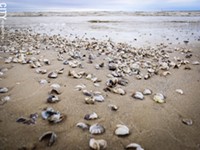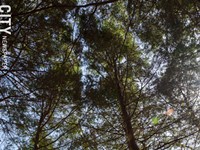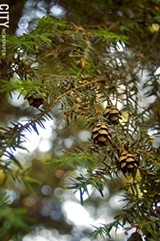[
{
"name": "500x250 Ad",
"insertPoint": "5",
"component": "15667920",
"parentWrapperClass": "",
"requiredCountToDisplay": "1"
}
]
The hemlock wooly adelgid is a tiny invasive pest, similar to aphids, that preys on native and ornamental hemlock trees. The bugs kill the trees needle by needle and limb by limb; an unaddressed infestation can mean a slow death.
This summer, a crew from the state Department of Environmental Conservation is surveying the state for new or expanded hemlock wooly adelgid sites. They started in Western New York and will soon be searching for infestations in the Finger Lakes region.
But the adelgid has already made its way into Monroe County. City workers have identified early-stage infestations in some Mt. Hope Cemetery hemlocks, as well as in trees near the Cobb's Hill reservoir, says Brian Liberti, the city forester.
At least one resident has said that the adelgid is present in the Cobb's Hill neighborhood, too.
"It's likely that it's spread throughout the city," says DEC regional forester Mark Gooding.
Last year, the DEC confirmed an infestation in Durand-Eastman Park, Gooding says. And a map provided by the department shows that DEC crews identified at least one infestation in Webster.
But the bugs have been here since at least 2003, when infestations were found in some Greece, Brighton, and Irondequoit neighborhoods. State and local officials worked to isolate and destroy the known populations, but the bugs may have persisted in some pockets, Gooding says.
Hemlock wooly adelgids are easily transported to new trees by other insects and birds, though the populations tend to spread slowly. Infestations typically show up as fuzzy, white growths on the underside of hemlock branches.
The region has far fewer hemlocks than ash, another tree under attack by an invasive insect: the emerald ash borer. But hemlock provide important habitat and water quality benefits, which is a big reason why forestry officials want to protect them.
Afflicted trees will still live quite a few years before the pests kill them, Gooding says. And if only a small number of trees in an area are infested, chemical treatments can be an effective way to kill the bugs; the treatments become cost-prohibitive when more than a few trees are involved. The city is looking into chemically treating some of its infested trees, Liberti says.
Researchers have also been experimenting with biological approaches for keeping the bug in check. The hemlock wooly adelgid has no natural predator on the east coast, so researchers have released non-native beetles and silver flies that feed on the pest.
Beetles have been released at infestations in Durand-Eastman Park and the Hemlock Lake state forest, Gooding says. The predators won't eradicate the hemlock wooly adelgid, but they will help keep populations under control, he says.
Speaking of...
-

Shells spell distress
Jan 25, 2017 -

Volunteers needed to save Eastern hemlocks
Mar 30, 2016 -

The City Seen: October 16-20
Oct 21, 2015 - More »
Latest in News
More by Jeremy Moule
-

ROCHESTER TEN
ANNETTE RAMOSAug 1, 2023 - More »






